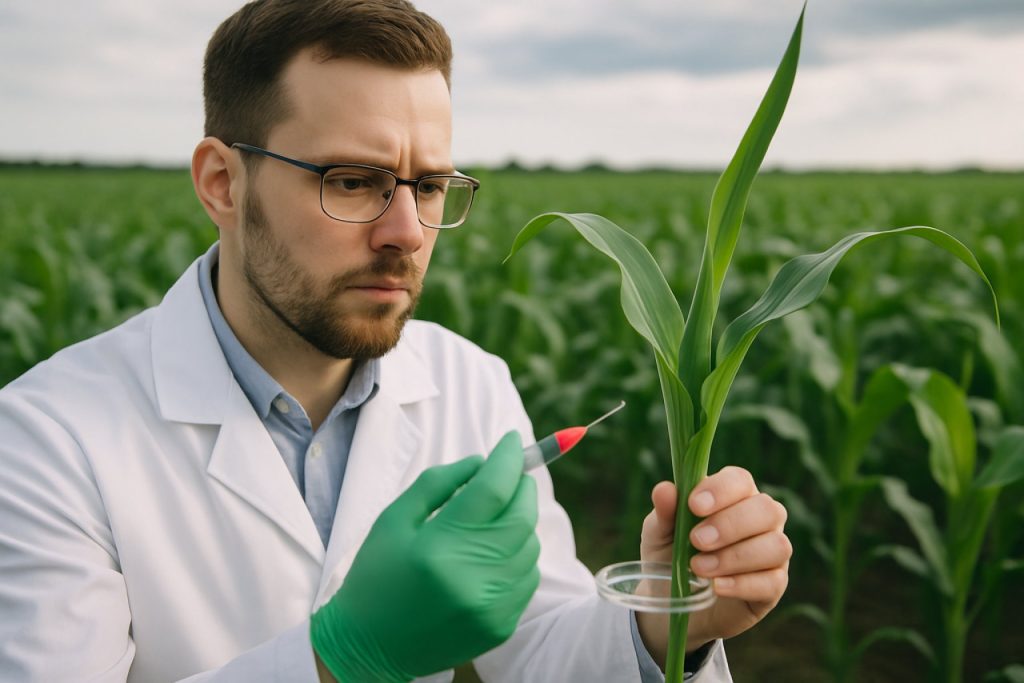
Herbicide-Resistant Crop Gene Editing in 2025: Unleashing Next-Gen Agricultural Innovation and Market Expansion. Explore How Precision Gene Editing is Reshaping Global Crop Protection and Yields.
- Executive Summary: 2025 Market Snapshot & Key Trends
- Market Size, Growth Rate, and Forecasts to 2030
- Breakthrough Technologies: CRISPR, TALENs, and Beyond
- Leading Players and Strategic Partnerships (e.g., bayer.com, corteva.com, basf.com)
- Regulatory Landscape: Global Approvals and Policy Shifts
- Adoption Drivers: Farmer Economics, Sustainability, and Yield Gains
- Competitive Analysis: Traditional GMOs vs. Gene-Edited Crops
- Intellectual Property and Licensing Dynamics
- Challenges: Resistance Management, Public Perception, and Trade
- Future Outlook: Innovation Pipeline and Market Opportunities
- Sources & References
Executive Summary: 2025 Market Snapshot & Key Trends
The global market for herbicide-resistant crop gene editing is poised for significant activity in 2025, driven by technological advancements, regulatory shifts, and evolving agricultural demands. Gene editing technologies, particularly CRISPR-Cas systems, are enabling the precise development of crops with enhanced resistance to widely used herbicides such as glyphosate and glufosinate. This innovation is central to addressing weed management challenges and supporting sustainable intensification of agriculture.
Major agricultural biotechnology companies are at the forefront of this sector. Bayer AG continues to expand its portfolio of herbicide-tolerant traits, leveraging both traditional genetic modification and advanced gene editing. Corteva Agriscience is actively developing CRISPR-edited crops, with a focus on traits that confer resistance to multiple herbicides, aiming to provide farmers with flexible weed control options. BASF SE is also investing in gene editing platforms to enhance its seed and trait offerings, particularly in soybean and canola.
In 2025, the commercial pipeline includes several gene-edited crops nearing regulatory approval or market launch in key regions. For example, gene-edited canola and soybean varieties with novel herbicide resistance traits are expected to reach North American and South American markets, reflecting the growing acceptance of gene-edited products under streamlined regulatory frameworks in countries such as the United States, Brazil, and Argentina. The U.S. Department of Agriculture’s updated regulatory approach, which exempts certain gene-edited crops from stringent GMO regulations, is accelerating product development and commercialization timelines.
Industry data indicates that the adoption of herbicide-resistant gene-edited crops is likely to expand rapidly over the next few years, particularly in major row crop markets. This growth is underpinned by the need to combat herbicide-resistant weeds and reduce the environmental impact of chemical applications. Companies are also exploring stacked traits, combining herbicide resistance with other beneficial characteristics such as drought tolerance and improved yield.
Looking ahead, the sector is expected to see increased collaboration between technology developers, seed companies, and agrochemical suppliers. Strategic partnerships and licensing agreements are anticipated to proliferate, as companies seek to integrate gene editing into broader crop protection and digital agriculture platforms. The outlook for 2025 and beyond suggests robust market growth, with gene-edited herbicide-resistant crops playing a pivotal role in the evolution of global agricultural systems.
Market Size, Growth Rate, and Forecasts to 2030
The global market for herbicide-resistant crop gene editing is poised for robust growth through 2030, driven by increasing demand for higher agricultural productivity, evolving regulatory frameworks, and the rapid adoption of advanced gene-editing technologies. As of 2025, the sector is characterized by a strong pipeline of gene-edited crop varieties, particularly in major row crops such as soybean, maize, and canola. Leading agricultural biotechnology companies, including Corteva Agriscience, Bayer AG, and BASF, are actively investing in the development and commercialization of herbicide-resistant traits using CRISPR and other gene-editing platforms.
Recent product launches and regulatory approvals are accelerating market expansion. For example, Corteva Agriscience has advanced several gene-edited soybean and corn varieties with enhanced herbicide tolerance, targeting both North and South American markets. Similarly, Bayer AG continues to expand its portfolio of herbicide-tolerant crops, leveraging both traditional genetic modification and newer gene-editing techniques. BASF is also collaborating with seed companies and technology providers to bring gene-edited herbicide-resistant crops to market, focusing on traits that address weed resistance and improve crop management flexibility.
The market size for herbicide-resistant crop gene editing is expected to grow at a compound annual growth rate (CAGR) in the high single digits to low double digits through 2030, with North America and South America leading adoption due to favorable regulatory environments and large-scale commercial agriculture. The Asia-Pacific region is anticipated to see accelerated growth in the latter half of the decade as regulatory clarity improves and local companies, such as Syngenta Group, increase their focus on gene-edited crop development.
Key growth drivers include the rising prevalence of herbicide-resistant weeds, the need for sustainable crop production, and the cost-effectiveness of gene editing compared to traditional transgenic approaches. The outlook for 2025 and beyond is further bolstered by ongoing collaborations between technology developers and seed companies, as well as increasing acceptance of gene-edited crops by regulatory agencies in the United States, Brazil, and other major agricultural economies.
Overall, the herbicide-resistant crop gene editing market is set for significant expansion through 2030, underpinned by technological innovation, strategic partnerships, and evolving global food security needs. The continued leadership of major players such as Corteva Agriscience, Bayer AG, BASF, and Syngenta Group will be instrumental in shaping the market’s trajectory.
Breakthrough Technologies: CRISPR, TALENs, and Beyond
The landscape of herbicide-resistant crop development is undergoing rapid transformation in 2025, driven by advanced gene editing technologies such as CRISPR-Cas9, TALENs, and emerging base editing platforms. These tools enable precise, targeted modifications to plant genomes, allowing for the introduction or enhancement of herbicide resistance traits with unprecedented efficiency and specificity.
CRISPR-Cas9 remains the most widely adopted technology in this space, owing to its simplicity, cost-effectiveness, and versatility. Major agricultural biotechnology companies, including Bayer and Corteva Agriscience, are actively leveraging CRISPR to develop next-generation herbicide-tolerant crops. For instance, Corteva Agriscience has announced ongoing field trials of CRISPR-edited maize and soybean varieties with resistance to multiple herbicide modes of action, aiming to address the growing challenge of weed resistance and provide farmers with more flexible weed management options.
TALENs (Transcription Activator-Like Effector Nucleases) continue to play a significant role, particularly in crops where CRISPR delivery or off-target effects present challenges. Companies such as BASF are exploring TALENs for editing complex polyploid crops and stacking multiple resistance traits. The precision of TALENs makes them suitable for regulatory environments that demand minimal unintended genetic changes.
Beyond CRISPR and TALENs, base editing and prime editing are emerging as promising technologies for herbicide resistance. These methods allow for single-nucleotide changes without introducing double-strand breaks, reducing the risk of off-target effects. Startups and research collaborations, often in partnership with established seed companies, are piloting these approaches in wheat, rice, and canola, with commercial launches anticipated within the next three to five years.
Regulatory frameworks are evolving in parallel with technological advances. In the United States, the USDA has streamlined the approval process for gene-edited crops that do not contain foreign DNA, expediting the path to market for CRISPR-edited herbicide-resistant varieties. Similar regulatory modernization is underway in countries such as Brazil and Australia, fostering a more innovation-friendly environment.
Looking ahead, the integration of gene editing with digital agriculture platforms and precision application technologies is expected to further enhance the sustainability and efficacy of herbicide-resistant crops. As leading companies like Syngenta and Bayer invest in R&D and strategic partnerships, the next few years are poised to see a wave of new, highly targeted herbicide-resistant crop varieties entering global markets, offering improved yields and reduced environmental impact.
Leading Players and Strategic Partnerships (e.g., bayer.com, corteva.com, basf.com)
The landscape of herbicide-resistant crop gene editing in 2025 is shaped by a handful of multinational agribusinesses and a growing network of strategic partnerships. These collaborations are driving both technological innovation and the global commercialization of gene-edited crops designed to withstand specific herbicides, thereby supporting more efficient weed management and crop productivity.
Among the leading players, Bayer remains at the forefront, leveraging its extensive R&D infrastructure and global seed business. Bayer’s pipeline includes gene-edited soybean and corn varieties with resistance to multiple herbicides, building on its legacy of glyphosate-tolerant crops. The company is also investing in next-generation gene editing tools, such as CRISPR, to develop traits with more precise resistance profiles and reduced regulatory hurdles.
Corteva Agriscience is another major force, with a strong focus on CRISPR-Cas gene editing for herbicide resistance. Corteva’s collaborations with academic institutions and technology startups have accelerated the development of crops resistant to new classes of herbicides, including those targeting hard-to-control weeds. The company’s Enlist™ system, which combines herbicide-tolerant traits with proprietary herbicide formulations, continues to expand in North and South America, with new gene-edited variants expected to enter regulatory review in the next few years.
BASF is actively advancing its gene editing capabilities through both internal R&D and external partnerships. BASF’s focus includes developing canola, soybean, and wheat varieties with resistance to multiple herbicides, aiming to provide growers with flexible weed control options. The company has also entered into licensing agreements with technology providers to access advanced gene editing platforms, positioning itself to rapidly commercialize new traits as regulatory frameworks evolve.
Strategic partnerships are increasingly central to progress in this sector. For example, Bayer and BASF have previously collaborated on herbicide-tolerant trait stacks, and similar alliances are expected to intensify as gene editing technologies mature. Additionally, Corteva’s open innovation model encourages partnerships with universities and biotech startups, fostering a pipeline of novel gene-edited traits.
Looking ahead, the next few years are likely to see further consolidation among leading players, as well as the entry of new technology-driven firms specializing in gene editing. The competitive landscape will be shaped by the ability to navigate evolving regulatory environments, secure intellectual property, and deliver value-added traits to growers worldwide.
Regulatory Landscape: Global Approvals and Policy Shifts
The regulatory landscape for herbicide-resistant crop gene editing is undergoing significant transformation as of 2025, reflecting both technological advances and evolving policy frameworks. In recent years, several countries have updated their regulatory approaches to gene-edited crops, distinguishing them from traditional genetically modified organisms (GMOs) and streamlining approval processes for certain gene-edited traits, particularly those conferring herbicide resistance.
In the United States, the United States Department of Agriculture (USDA) has implemented the SECURE rule, which exempts certain gene-edited crops from lengthy regulatory review if the genetic changes could have been achieved through conventional breeding. This has accelerated the development and commercialization of herbicide-resistant varieties by major seed companies such as Bayer and Corteva Agriscience. Both companies have announced pipelines of gene-edited crops, including soybean and corn varieties with novel herbicide resistance traits, expected to reach the market in the next few years.
In the European Union, regulatory policy remains more restrictive. However, in 2023, the European Commission proposed new legislation to differentiate between gene-edited crops (produced via targeted mutagenesis) and transgenic GMOs. If adopted, this could allow for a simplified approval process for certain gene-edited, herbicide-resistant crops by 2025 or shortly thereafter, potentially opening the EU market to products from companies like Syngenta and BASF, both of which are actively developing gene-edited crop technologies.
In Asia, regulatory shifts are also evident. Japan and Australia have clarified that gene-edited crops without foreign DNA are not regulated as GMOs, enabling faster commercialization. For example, Mitsui & Co. and Sumitomo Chemical are investing in gene-editing platforms to develop herbicide-resistant rice and wheat, aiming for market entry within the next few years.
Latin American countries, including Brazil and Argentina, have adopted science-based, case-by-case regulatory frameworks that often exempt certain gene-edited crops from GMO regulations. This has encouraged local and multinational companies to invest in herbicide-resistant gene-edited soybeans and maize, with approvals and commercial launches anticipated through 2025 and beyond.
Looking ahead, the global regulatory environment is expected to become more harmonized, with increasing recognition of the distinctions between gene editing and traditional genetic modification. This trend is likely to facilitate broader adoption and international trade of herbicide-resistant gene-edited crops, provided that companies continue to engage with regulators and stakeholders to address safety, transparency, and labeling concerns.
Adoption Drivers: Farmer Economics, Sustainability, and Yield Gains
The adoption of herbicide-resistant crop gene editing is accelerating in 2025, driven by a confluence of economic, agronomic, and sustainability factors. Farmers are increasingly seeking solutions that address rising input costs, labor shortages, and the need for more sustainable production systems. Gene-edited crops with herbicide resistance offer a compelling value proposition by enabling more effective weed control, reducing the need for tillage, and supporting conservation agriculture practices.
From an economic perspective, herbicide-resistant gene-edited crops can lower production costs by simplifying weed management and reducing the frequency and volume of herbicide applications. For example, Corteva Agriscience and BASF have both advanced gene-edited soybean and canola varieties that tolerate multiple herbicide modes of action, allowing for more flexible and cost-effective weed control strategies. These technologies are particularly attractive in regions facing herbicide-resistant weed populations, where traditional chemical control is becoming less effective and more expensive.
Yield gains are another significant driver. By minimizing weed competition throughout the growing season, gene-edited herbicide-resistant crops can help secure higher and more stable yields. Field trials and early commercial plantings reported by Syngenta and Bayer AG indicate that gene-edited traits can deliver yield improvements of 5–10% compared to conventional varieties under moderate to high weed pressure. These gains are especially important as global demand for food, feed, and biofuels continues to rise.
Sustainability considerations are also central to adoption. Gene editing enables the development of crops that are resistant to a broader spectrum of herbicides, including those with more favorable environmental profiles. This supports integrated weed management and reduces reliance on any single herbicide, helping to slow the evolution of resistant weed biotypes. Additionally, herbicide-resistant crops facilitate reduced- or no-till farming, which can lower greenhouse gas emissions, improve soil health, and reduce erosion. Companies such as Corteva Agriscience and BASF are actively promoting these sustainability benefits as part of their product stewardship and outreach programs.
Looking ahead, the outlook for herbicide-resistant crop gene editing remains robust. Regulatory clarity in key markets, ongoing investment by major seed and agrochemical companies, and growing farmer demand for resilient, high-performing varieties are expected to drive further adoption through the late 2020s. As more gene-edited crops reach commercial scale, the cumulative benefits for farm economics, productivity, and environmental sustainability are likely to become even more pronounced.
Competitive Analysis: Traditional GMOs vs. Gene-Edited Crops
The competitive landscape for herbicide-resistant crops is rapidly evolving as gene editing technologies, particularly CRISPR/Cas9 and TALENs, challenge the dominance of traditional genetically modified organisms (GMOs). Historically, herbicide resistance in crops was achieved through transgenic approaches, introducing foreign genes—most notably the glyphosate-resistance trait pioneered by Bayer (formerly Monsanto) in its Roundup Ready crops. These GMOs have been widely adopted since the 1990s, with over 190 million hectares of herbicide-tolerant crops planted globally by 2023, according to industry data from International Service for the Acquisition of Agri-biotech Applications.
Gene editing, however, offers a more precise and potentially less controversial alternative. Unlike traditional GMOs, gene-edited crops can be developed by making targeted changes to the plant’s own genome without introducing foreign DNA. This distinction is significant for regulatory and consumer acceptance. Companies such as Corteva Agriscience and BASF are at the forefront of commercializing gene-edited herbicide-resistant crops. For example, Corteva Agriscience has developed waxy corn and is advancing CRISPR-edited soybean varieties with improved herbicide tolerance, while BASF is investing in gene editing platforms for multiple row crops.
The competitive advantage of gene-edited crops lies in their regulatory status in key markets. In the United States, the USDA has clarified that certain gene-edited crops are not regulated as GMOs if they do not contain foreign DNA, streamlining their path to market. This has enabled companies to accelerate product development timelines and reduce costs compared to traditional GMOs, which face more stringent and lengthy approval processes. In 2024 and 2025, several gene-edited herbicide-resistant crops are expected to reach commercial launch or advanced field trials, with Corteva Agriscience and BASF leading the charge.
Despite these advantages, traditional GMOs retain a strong market presence due to established supply chains, farmer familiarity, and robust intellectual property portfolios held by major players like Bayer. However, as gene editing technologies mature and regulatory frameworks in regions such as the EU and South America evolve, the competitive balance is expected to shift. By 2025 and beyond, gene-edited herbicide-resistant crops are poised to capture a growing share of the market, particularly in countries with favorable regulatory environments and rising demand for sustainable, precision agriculture solutions.
Intellectual Property and Licensing Dynamics
The intellectual property (IP) and licensing landscape for herbicide-resistant crop gene editing is rapidly evolving as major agricultural biotechnology companies and research institutions intensify their focus on next-generation gene editing technologies. As of 2025, the sector is characterized by a complex web of patents, licensing agreements, and strategic collaborations, particularly around CRISPR/Cas and other precision gene editing platforms.
Historically, the first wave of herbicide-resistant crops—such as glyphosate-tolerant soybeans and corn—were developed using transgenic approaches and dominated by a handful of large corporations. Bayer (which acquired Monsanto), Corteva Agriscience, and BASF remain key players, holding extensive patent portfolios covering both the traits themselves and the enabling technologies. These companies have established broad licensing networks, allowing seed companies and growers access to proprietary traits under various agreements.
The advent of gene editing, particularly CRISPR-based methods, has introduced new IP challenges and opportunities. Patent rights for CRISPR/Cas9 and related systems are held by a mix of academic institutions and commercial entities, leading to ongoing disputes and negotiations over freedom-to-operate. Companies such as Syngenta and BASF have entered into licensing agreements with technology developers to secure access to gene editing tools for herbicide resistance trait development. For example, Corteva Agriscience has established its own CRISPR platform and entered into cross-licensing arrangements to expand its portfolio and reduce legal risks.
In 2025, the licensing environment is further shaped by regulatory distinctions between gene-edited and transgenic crops. In several jurisdictions, gene-edited crops that do not contain foreign DNA are subject to less stringent regulation, which has encouraged more companies—including smaller seed developers—to pursue in-house gene editing programs or seek licenses from major patent holders. This trend is expected to accelerate over the next few years, potentially democratizing access to herbicide-resistant traits but also increasing the complexity of IP management.
- Large multinationals such as Bayer, Corteva Agriscience, and BASF continue to consolidate their IP positions through acquisitions and strategic partnerships.
- Emerging players and public research institutions are increasingly active in patent filings, particularly for novel gene editing methods and specific herbicide resistance alleles.
- Licensing models are shifting toward more flexible, trait-specific agreements, with some companies offering non-exclusive licenses to broaden market adoption.
Looking ahead, the next few years will likely see intensified competition for key patents, ongoing litigation, and the emergence of new licensing frameworks as gene editing technologies mature. The balance between protecting innovation and enabling broad access will be a central issue, with implications for both industry structure and the pace of herbicide-resistant crop deployment worldwide.
Challenges: Resistance Management, Public Perception, and Trade
The rapid advancement of gene editing technologies, particularly CRISPR-based methods, has enabled the development of herbicide-resistant crops with unprecedented precision. However, as these crops enter commercial pipelines in 2025 and beyond, several challenges persist—most notably in resistance management, public perception, and international trade.
Resistance Management: The widespread adoption of herbicide-resistant crops, such as those engineered to tolerate glyphosate, glufosinate, or new herbicide modes of action, raises concerns about the accelerated evolution of herbicide-resistant weeds. Companies like Bayer and BASF have introduced gene-edited varieties with stacked resistance traits, aiming to provide farmers with more flexible weed control options. However, industry bodies such as the CropLife International emphasize the need for integrated weed management strategies to delay resistance development. In 2025, stewardship programs and best practice guidelines are being updated to address the risk of over-reliance on single herbicide modes of action, with regulatory agencies in North America and the EU requiring resistance management plans as part of product approvals.
Public Perception: Despite the technical distinction between gene-edited and transgenic crops, public acceptance remains a significant hurdle. Surveys in the EU and parts of Asia indicate persistent skepticism toward gene-edited food, even as regulatory frameworks begin to differentiate between traditional GMOs and newer gene-edited products. Companies such as Corteva Agriscience and Syngenta are investing in transparent communication and stakeholder engagement to build trust. In 2025, labeling requirements for gene-edited crops vary widely by jurisdiction, with the EU maintaining strict traceability, while the US and Brazil have adopted more permissive stances for certain gene-edited traits.
Trade Implications: Divergent regulatory approaches to gene-edited herbicide-resistant crops are creating uncertainty in global trade. For example, while the US Department of Agriculture has streamlined approvals for gene-edited crops that do not contain foreign DNA, the European Union continues to regulate them under its GMO legislation, leading to potential trade disruptions. Industry groups, including CropLife International, are advocating for greater international harmonization to prevent non-tariff barriers and facilitate the movement of agricultural commodities. In 2025 and the coming years, the alignment of regulatory standards will be critical for the global adoption and commercialization of gene-edited herbicide-resistant crops.
Looking ahead, the success of herbicide-resistant crop gene editing will depend on robust resistance management, transparent public engagement, and international regulatory cooperation. The industry’s ability to address these challenges will shape the trajectory of gene-edited crop adoption through the remainder of the decade.
Future Outlook: Innovation Pipeline and Market Opportunities
The innovation pipeline for herbicide-resistant crop gene editing is poised for significant expansion in 2025 and the following years, driven by advances in CRISPR and other precision breeding technologies. Major agricultural biotechnology companies are intensifying their R&D efforts to develop next-generation crops that can withstand a broader spectrum of herbicides, address resistance management, and meet evolving regulatory and consumer expectations.
Key industry leaders such as Bayer, Corteva Agriscience, and BASF are actively investing in gene editing platforms to introduce new herbicide-tolerant traits in staple crops like soybean, corn, and canola. For instance, Bayer continues to expand its portfolio of herbicide-tolerant seeds, leveraging both traditional transgenic approaches and CRISPR-based editing to address glyphosate and glufosinate resistance. Corteva Agriscience is advancing its proprietary gene editing technologies to develop crops with tolerance to multiple herbicide modes of action, aiming to provide farmers with more flexible and sustainable weed management options.
The innovation pipeline is also being shaped by collaborations between multinational corporations and specialized biotech firms. BASF has entered into partnerships to accelerate the development of gene-edited crops with novel herbicide resistance traits, focusing on both major row crops and specialty crops. These collaborations are expected to yield new product launches as early as 2025, pending regulatory approvals in key markets such as the United States, Brazil, and parts of Asia.
In addition to large corporations, emerging players and academic spin-offs are contributing to the diversification of the innovation landscape. Companies like Syngenta are exploring gene editing to create crops with stacked resistance traits, which can help mitigate the spread of herbicide-resistant weeds and reduce the need for chemical inputs. The focus is increasingly on developing crops that are compatible with integrated weed management systems, aligning with global sustainability goals.
Looking ahead, the market opportunities for gene-edited, herbicide-resistant crops are substantial. The adoption of these crops is expected to accelerate as regulatory frameworks in major agricultural economies become more accommodating to gene editing technologies. The U.S. Department of Agriculture and similar agencies in other countries are streamlining approval processes for gene-edited crops that do not contain foreign DNA, which could facilitate faster commercialization and broader market access.
Overall, the next few years will likely see a wave of new product introductions, expanded trait portfolios, and increased farmer adoption, positioning gene-edited herbicide-resistant crops as a cornerstone of modern, sustainable agriculture.
Sources & References
- Corteva Agriscience
- BASF SE
- Syngenta Group
- United States Department of Agriculture (USDA)
- Corteva Agriscience
- Syngenta
- BASF
- Sumitomo Chemical
- International Service for the Acquisition of Agri-biotech Applications
- CropLife International



